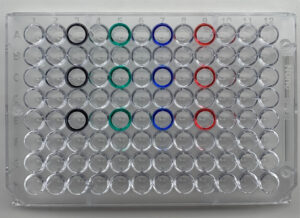Do you use markers on the lip of your tubes or on 96well plates. It might be time to rethink that.

“Our data suggest that the so-called permanent markers are not so permanent after all. Marking the rim of the wells was enough to contaminate the wells and thereby stain the cells during the staining procedure. This issue was discovered in a complex staining panel, however, to illustrate the problem, a simple unstained setup was made.
Interestingly, the red marker gave rise to the most pronounced staining of the cells, however, not in the two detectors off the red laser (R660 and R780). This is due to the fact that the pigment in the red maker is not excited by the red laser.
The violet laser (405 nm) seems not to be very efficient in exciting the pigment from the permanent markers, therefore very little staining of the cells was seen in V445 and V780.
However, the blue and green markers can also result in staining, even though not as apparent, the danger is, that this slight staining might be overlooked as a positive signal.
Based on our study, we recommend only using a black permanent marker to highlight wells or tubes of interest for flow cytometry experiments, and even better, completely avoid marking the rim of tubes and plates or marking the bottom to avoid contamination.”
